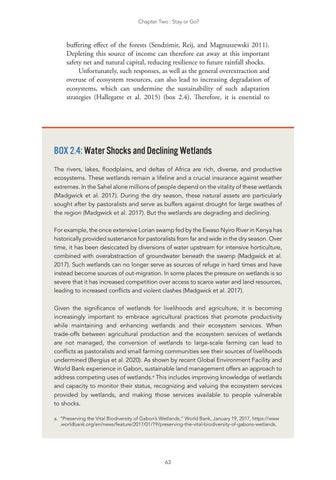Chapter Two : Stay or Go?
buffering effect of the forests (Sendzimir, Reij, and Magnuszewski 2011). Depleting this source of income can therefore eat away at this important safety net and natural capital, reducing resilience to future rainfall shocks. Unfortunately, such responses, as well as the general overextraction and overuse of ecosystem resources, can also lead to increasing degradation of ecosystems, which can undermine the sustainability of such adaptation strategies (Hallegatte et al. 2015) (box 2.4). Therefore, it is essential to
BOX 2.4: Water Shocks and Declining Wetlands The rivers, lakes, floodplains, and deltas of Africa are rich, diverse, and productive ecosystems. These wetlands remain a lifeline and a crucial insurance against weather extremes. In the Sahel alone millions of people depend on the vitality of these wetlands (Madgwick et al. 2017). During the dry season, these natural assets are particularly sought after by pastoralists and serve as buffers against drought for large swathes of the region (Madgwick et al. 2017). But the wetlands are degrading and declining. For example, the once extensive Lorian swamp fed by the Ewaso Nyiro River in Kenya has historically provided sustenance for pastoralists from far and wide in the dry season. Over time, it has been desiccated by diversions of water upstream for intensive horticulture, combined with overabstraction of groundwater beneath the swamp (Madgwick et al. 2017). Such wetlands can no longer serve as sources of refuge in hard times and have instead become sources of out-migration. In some places the pressure on wetlands is so severe that it has increased competition over access to scarce water and land resources, leading to increased conflicts and violent clashes (Madgwick et al. 2017). Given the significance of wetlands for livelihoods and agriculture, it is becoming increasingly important to embrace agricultural practices that promote productivity while maintaining and enhancing wetlands and their ecosystem services. When trade-offs between agricultural production and the ecosystem services of wetlands are not managed, the conversion of wetlands to large-scale farming can lead to conflicts as pastoralists and small farming communities see their sources of livelihoods undermined (Bergius et al. 2020). As shown by recent Global Environment Facility and World Bank experience in Gabon, sustainable land management offers an approach to address competing uses of wetlands.a This includes improving knowledge of wetlands and capacity to monitor their status, recognizing and valuing the ecosystem services provided by wetlands, and making those services available to people vulnerable to shocks. a. “Preserving the Vital Biodiversity of Gabon’s Wetlands,” World Bank, January 19, 2017, https://www .worldbank.org/en/news/feature/2017/01/19/preserving-the-vital-biodiversity-of-gabons-wetlands.
63



